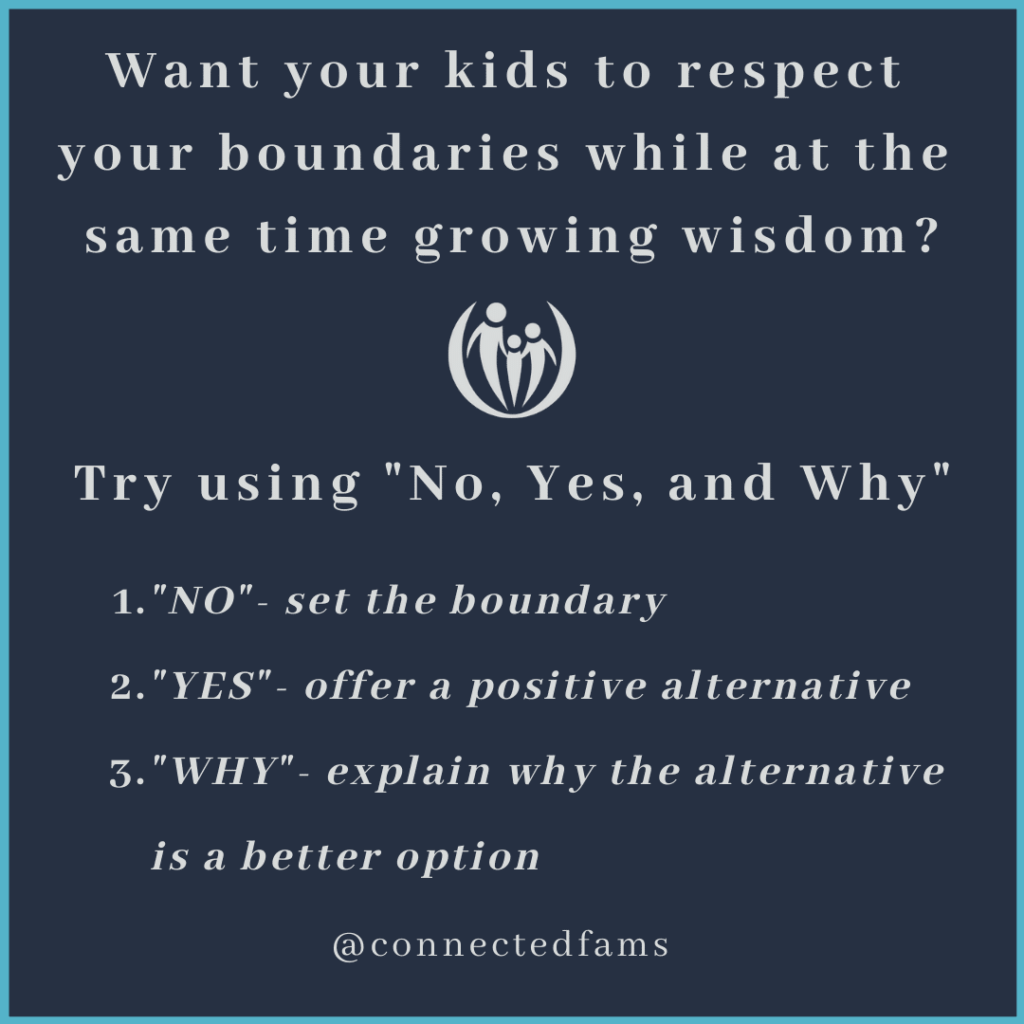
How to Say “No” to Kids Without the Power Struggles

Think about how it usually goes: Your child focuses on a goal (even if it is a really bad goal like “teaching little sister a lesson”), 😆 and then you come in with big energy, and a firm,“No!” We all know the result of a loud, frustrated, “No, you may not!” Our kids’ default response to “No!” is frustration, resentment, or even a meltdown.
How you say “No.” matters. When we look at the Bible, it gives us another way to say no respectfully to kids. A way that still enforces boundaries, but also helps kids grow in wisdom.
The importance of saying no to your child and the problem
There are many reasons why parents should say no to their children. “Children raised by permissive parents tend to lack self-discipline, possess poor social skills, may be self-involved and demanding, and may feel insecure due to the lack of boundaries and guidance.” Research says that overly permissive parenting also leads to kids who struggle more with low achievement, poor decision making, delinquent behavior, and addiction.
Instead of focusing on what might happen if you don’t set good boundaries and say no, put your focus on all your child might learn when you set boundaries well: helpful responses to authority, resilience when facing a blocked goal, and delay of gratification to name a few.
“[Researchers] found that children raised with an “authoritative” parenting style – where parents set clear limits and expectations while also being supportive of their children – assumed more leadership roles at work and in their communities later in life… [and] these children were also less likely to engage in serious rule-breaking…”
Feeling inspired by the value of making clear what is not ok for kids? But there’s still one little problem. Saying no poorly doesn’t demonstrate authoritative parenting. Instead, it throws you into some intense power struggles!
Read on to learn how you can say no to your child in a way that strengthens cooperation and wisdom, and decreases defiance. The Bible has some great examples for us.

How Paul said “no” to the church
In Ephesians 4, Paul writes to the church in Ephesus to help guide them toward mature faith. To that end, he gives them a series of commands. A list of behaviors they shouldn’t do. But he doesn’t stop there. There is a clear pattern that goes deeper than merely saying, “No”.
Here’s one example in Ephesians 4:28:
Anyone who has been stealing must steal no longer, but must work, doing something useful with their own hands, that they may have something to share with those in need.
No-Yes-Why
Paul starts with the “no”: “Anyone who has been stealing must steal no longer”. But then he adds two more important pieces: a “yes” and a “why”. These three parts — no, yes, and why — work together to help grow wisdom by setting a boundary (no), offering a positive alternative (yes), and explaining why the alternative is a better option (why).
Instead of just telling the Ephesians to “stop stealing” (no), he also tells them what to do instead: “work, doing something useful with their own hands” (yes), explaining that this is a better option because then they “may have something to share with those in need” (why).
More No-Yes-Why examples
Let’s look at a couple more examples of Paul’s No-Yes-Why in this letter to the Ephesians:
- “Therefore each of you must put off falsehood (no) and speak truthfully to your neighbor (yes), for we are all members of one body (why).” (v.25)
- “Do not let any unwholesome talk come out of your mouths (no), but only what is helpful for building others up according to their needs (yes), that it may benefit those who listen (why).” (v.29)
Say “no” to your child but focus on the “yes”
As we look at these examples of Paul teaching wisdom with No-Yes-Why it reminds us to focus more on the positive than on the negative. This doesn’t mean we don’t set boundaries or give consequences (Paul still says “don’t do that”) but we give our biggest energy to the yes and the why, rather than the no.
Your non-verbals when you say “no”
If Paul were teaching these words, I can imagine his face lighting up when he describes the wonderful alternative God wants for us. For example, he probably would have used an expression that sent the message, “You can have the fulfillment of working hard, and the joy of sharing with those in need!”
Your facial expression can be the difference between a shaming lecture and mentoring wisdom.
When parents scowl their way through discipline, kids get the message we are against them, not for them. Using a firm expression to say no to your child communicates, “This is serious.” But then, let your face light up when you explain the yes and the why. That communicates that you really do want the best for your child, and you’re helping them discover it. Your facial expression can be the difference between a shaming lecture and mentoring wisdom.
As you read the practical examples below (maybe even out loud), change your expression between the firm no, and a gentle or smiling yes and why. See how different that feels. Your child will notice.
Practical examples of saying “no” with a bigger “yes” and “why”
What might it look like to say no firmly, but focus on a bigger “yes” and “why”? See if you can relate to any of these No-Yes-Why examples.
- If your child gets frustrated and whacks you, instead of exploding with a “NO, STOP IT, THAT IS NOT OKAY!”, take a second to calm down and try this:
- (Deep breath) No hitting! But you CAN use big, angry words to tell me what’s wrong. Then I can help you!
- For a child who drops a coat and backpack on the floor as soon as they come in the door:
- Don’t just drop your coat and backpack when you come in. You can hang them on the hook instead — and you can come back in the front door and practice that to help you remember. Then no one will trip over them and you’ll be able to find them easier in the morning.
- For a child who complains about what’s served for dinner:
- No complaining about the food at dinner. If you don’t want to eat it, you can politely say, “No, thank you.” That way you honor the cook who worked hard to fix the meal, and you learn to say what you want in a respectful way.
- For a child who takes out their schoolwork frustrations on you.
- It’s not ok to yell at me when you’re frustrated with math. You can say loudly, “I’m frustrated and I need a break!” That will help you get what you need so you can finish well and feel good about how you handled your frustration.
Even though it might not feel natural, you can learn to respond to children this way. Over time, it will begin to defuse a lot of recurring conflicts. And it will certainly set good boundaries and teach kids some wise alternatives in the process!
So consider, what is a common scenario where you often find yourself saying “No!” or “Stop it!” to your child? How could you reframe your response to be a No-Yes-Why instead?
One mom’s experience using No-Yes-Why with her feisty 4-year-old twin boys
I’ve read a handful of articles on how to avoid saying unnecessary “no’s” and while I get that, A) sometimes “no” is necessary, and B) I usually remember what I should have done after I already started with a “no” or a “stop.”
Learning the No-Yes-Why strategy has been a game changer.
Most of my issues are safety infractions (because two 4-year-old boys…). Usually I get out a quick and energetic (occasionally panicked) “STOP!!!” before remembering my parenting goals.
It’s too late to not say no! And often it needs to be the firmest, life-saving ‘no’ possible.
But using No-Yes-Why, I still get a chance to finish well. I have time to transfer all that energy on over to the Yes and Why. I’m startled. They’ve responded so well! They’re not pushing back nearly as much as they used to!
The funniest was when James started to ask an angry “why not” (his favorite question) when I told him to not spray the water hose into the house (“But you can spray the grass over there! That way nobody slips and falls on the wet tiles on the living room floor.”).
Suddenly he stopped himself and said, ‘Oh, you said so that I don’t get hurt. That’s okay.’”
Related Posts
What if my kids still do the thing?
You’ve learned how to say no, and you’ve told them what they can do and why. Good job. But nothing can guarantee compliance.
Kids are kids, and sin is sin. There will still be times that either real-life consequences or imposed consequences are needed to help kids keep learning. That’s okay.
If you put this process of No-Yes-Why in place, expect your kids to need correction sometimes. You might want to read through our free ebook,“Consequences that Actually Work” . There’s no magic formula. But No-Yes-Why might just diminish some of those power struggles as you set healthy boundaries for your kids. You can say no to your kids in a new way and feel good about it in the process.
Download our FREE in-depth ebook Helping Kids With Anger. It will provide thoughtful insights and creative ideas to help your struggling child.






